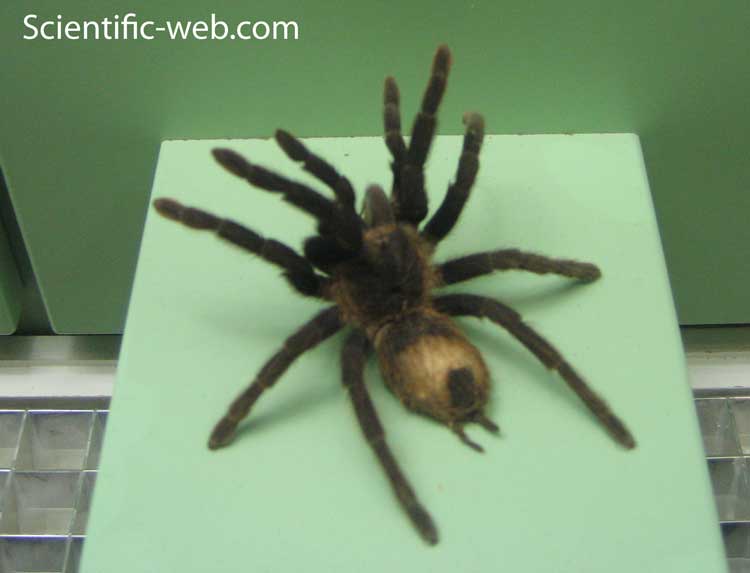
Tliltocatl vagans, Photo: Michael Lahanas
Superregnum: Eukaryota
Cladus: Unikonta
Cladus: Opisthokonta
Cladus: Holozoa
Regnum: Animalia
Subregnum: Eumetazoa
Cladus: Bilateria
Cladus: Nephrozoa
Cladus: Protostomia
Cladus: Ecdysozoa
Cladus: Panarthropoda
Phylum: Arthropoda
Subphylum: Chelicerata
Classis: Arachnida
Ordo: Araneae
Subordo: Opisthothelae
Infraordo: Mygalomorphae
Superfamilia: Theraphosoidea
Familia: Theraphosidae
Subfamilia: Theraphosinae
Genus: Tliltocatl
Species: Tliltocatl vagans
Name
Tliltocatl vagans (Ausserer, 1875)
Type locality: Mexico
Holotype: BMNH. male ♂. BMNH 1890-7-1-380-282.
Synonymy
Eurypelma vagans Ausserer, 1875: 197 (original combination)
Brachypelma vagans (Ausserer): Pocock, 1903: 103.
Tliltocatl vagans (Ausserer): Mendoza & Francke, 2020: 131
Eurypelma dupontii Becker, 1879: 143
References
Primary references
Ausserer, A. 1875. Zweiter Beitrag zur Kenntniss der Arachniden-Familie der Territelariae Thorell (Mygalidae Autor). Verhandlungen der Kaiserlich-Königlichen Zoologisch-Botanischen Gesellschaft in Wien 25: 125–206. Reference page.
Additional references
Mendoza, J. & Francke, O. 2020. Systematic revision of Mexican threatened tarantulas Brachypelma (Araneae: Theraphosidae: Theraphosinae), with a description of a new genus, and implications on the conservation. Zoological Journal of the Linnean Society 188: 82–147. DOI: 10.1093/zoolinnean/zlz046 Open access. Reference page.
Vernacular names
Deutsch: Schwarzrote Vogelspinne
English: Mexican Red Rump Tarantula
Nederlands: Mexicaanse Roodrompvogelspin
Tliltocatl vagans (synonym Brachypelma vagans) is a species of tarantula known commonly as the Mexican red rump. It ranges predominantly in Mexico (including the Yucatán Peninsula), but is also found in Central America.[1] They are terrestrial, burrowing spiders. The reason for the name red rump is because of its distinctive red hairs on its abdomen. Like most tarantulas, they will eat anything they can overpower, which is usually insects, but small lizards and rodents may also be consumed. They can grow up to a solid 6.5 inch leg span, with males typically being smaller and thinner than the females. They prefer shrubland habitats.
In 1996, Tliltocatl vagans was discovered in the wild in St. Lucie County, Florida. It is now considered an established non-native species in that state, where it is thought to have been introduced through either accidental or intentional releases of specimens imported via the pet trade, although their numbers have been dwindling due to many T. vagans eating insects poisoned by pesticides.
Distribution of confirmed specimens of Tliltocatl species[2]
█ Tliltocatl vagans
Taxonomy
The genus Brachypelma was split up, with this species moving to become Tliltocatl vagans.[3] The move is accepted by the World Spider Catalog.[1]
In captivity
T. vagans is frequently kept and bred in captivity. They are typically docile, though they can be skittish and prone to releasing urticating hairs. Females are long-lived, potentially reaching 25-40 years of age. Due to its popularity in the pet trade, T. vagans is listed under appendix II of CITES (under its former name) to prevent illegal removal and international trade. This trade, combined with habitat destruction and a high rate of mortality prior to sexual maturity, means that T. vagans is considered vulnerable to extinction.[4]
In traditional Mayan medicine
The Ch'ol Maya consider these spiders to be positive, and use them medicinally. A hierbatero kills it, then crushes it, mixes it with spirit alcohol and strains out any irritating hairs with a traditional cloth. The beverage is used for the treatment of "tarantula wind", the symptoms being chest pain, coughing and asthma. The venom peptide GsMtx-4 is being investigated for the possible treatment of cardiac arrhythmia, muscular dystrophy and glioma.[5]
References
"Taxon details Tliltocatl vagans (Ausserer, 1875)". World Spider Catalog. Natural History Museum Bern. Retrieved 2020-03-01.
Mendoza, Jorge & Francke, Oscar (2020). "Systematic revision of Mexican threatened tarantulas Brachypelma (Araneae: Theraphosidae: Theraphosinae), with a description of a new genus, and implications on the conservation". Zoological Journal of the Linnean Society. 188 (1): 82–147. doi:10.1093/zoolinnean/zlz046.
Mendoza, Jorge & Francke, Oscar (4 November 2019), "Systematic revision of Mexican threatened tarantulas Brachypelma (Araneae: Theraphosidae: Theraphosinae), with a description of a new genus, and implications on the conservation", Zoological Journal of the Linnean Society, doi:10.1093/zoolinnean/zlz046
"Mexican redrump tarantula (Brachypelma vagans)". Arkive. Wildscreen. Archived from the original on 2015-07-14. Retrieved 6 July 2015.
Salima Machkour-M'Rabet; Yann Hénaut; Peter Winterton & Roberto Rojo (2011). "A case of zootherapy with the tarantula Brachypelma vagans Ausserer, 1875 in traditional medicine of the Chol Mayan ethnic group in Mexico". Journal of Ethnobiology and Ethnomedicine. 7: 12. doi:10.1186/1746-4269-7-12. PMC 3072308. PMID 21450096.
Retrieved from "http://en.wikipedia.org/"
All text is available under the terms of the GNU Free Documentation License

